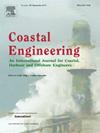河床波纹对管道/电缆冲刷跨伸长的影响
IF 4.5
2区 工程技术
Q1 ENGINEERING, CIVIL
引用次数: 0
摘要
本研究提供了实验室实验的结果,旨在研究在稳定电流下沿管道/电缆的冲刷传播。以往对该问题的研究大多表明,冲刷传播分为初级阶段和次级阶段,当冲刷孔达到某一临界长度时,就会向次级阶段过渡。然而,本研究的结果表明,在小尺度模型试验中,河床波纹对冲刷速率有直接影响,随着河床波纹的发展,河床波纹会从初级阶段过渡到次级阶段。通过比较波纹在管道/电缆上游形成之前和之后,以及通过压平上游床层消除波纹之后的冲刷传播速率,可以证明这一点。发现河床波纹对冲刷传播既有间接影响,也有直接影响。间接地,波纹通过改变边界层来降低近床层速度,而直接地,它们使流动向上偏转,遮蔽管道/电缆并减少流入冲刷锋面的流动。此外,进入冲刷锋面的泥沙通量可能因上游波纹的接近而改变,可能导致冲刷传播暂时停止。这项工作的发现对解释早期研究中的冲刷结果和设计未来的实验模型都有意义。本文章由计算机程序翻译,如有差异,请以英文原文为准。
Influence of bed ripples on scour-induced span elongation of pipelines/cables
This study presents results from laboratory experiments designed to investigate the scour propagation along a pipeline/cable under steady current. Most previous research on this topic has shown that the scour propagation has a primary and secondary stage, with the transition to the secondary stage believed to occur when the scour hole reaches some critical length. However, results from the present study show that in small-scale model testing, bed ripples have a direct influence on scour rate, causing a transition from a primary to secondary stage as they develop. This is demonstrated by comparing scour propagation rates before and after ripples develop upstream of the pipeline/cable, and after ripples are removed by flattening the upstream bed. It is found that bed ripples appear to have both an indirect and direct influence on scour propagation. Indirectly, ripples reduce near-bed velocity by altering the boundary layer, while directly they deflect flow upwards, sheltering the pipeline/cable and reducing flow into the scour front. Additionally, the sediment flux entering the scour front may be altered by the proximity of upstream ripples, potentially leading to temporary cessation of scour propagation. The findings from this work have implications both for interpreting scour results in earlier research and for designing future experimental models.
求助全文
通过发布文献求助,成功后即可免费获取论文全文。
去求助
来源期刊

Coastal Engineering
工程技术-工程:大洋
CiteScore
9.20
自引率
13.60%
发文量
0
审稿时长
3.5 months
期刊介绍:
Coastal Engineering is an international medium for coastal engineers and scientists. Combining practical applications with modern technological and scientific approaches, such as mathematical and numerical modelling, laboratory and field observations and experiments, it publishes fundamental studies as well as case studies on the following aspects of coastal, harbour and offshore engineering: waves, currents and sediment transport; coastal, estuarine and offshore morphology; technical and functional design of coastal and harbour structures; morphological and environmental impact of coastal, harbour and offshore structures.
 求助内容:
求助内容: 应助结果提醒方式:
应助结果提醒方式:


